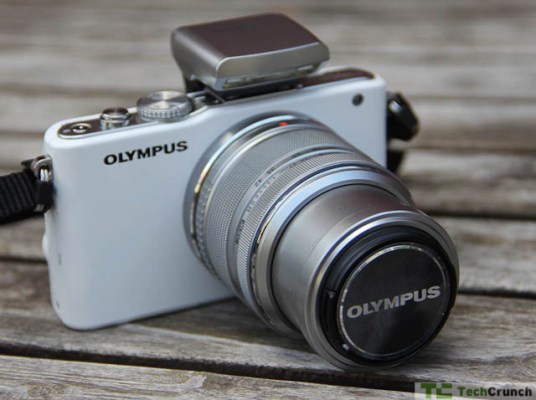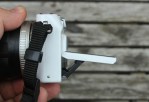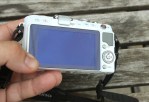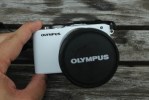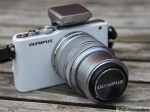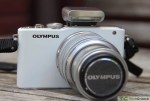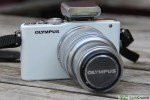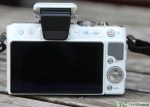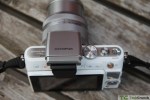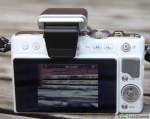Features:
- 12.3-Megapixel Live MOS image sensor
- Tilting 3.0-inch screen
- 3D Photo support
- ISO up to 12800
- 1080/60i AVCHD or AVI video recording
- MSRP: $699
Pros:
- Amazingly small
- Excellent video recording
- Fast shutter speed
Cons:
- Pricey
- Lenses are pricier
- No flash
Short Version
It’s hard to recommend the E-PL3 over the more powerful and touchscreen-equipped E-P3 but if you’re in the market for a much more compact micro 4/3s shooter and you can survive without a built-in flash, this may be the camera for you.
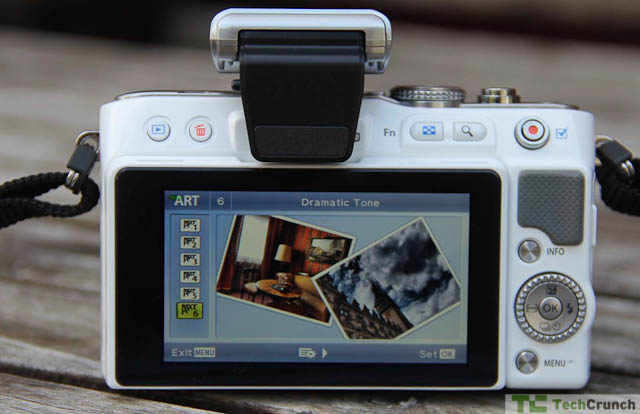
As Olympus perfects its micro 4/3s chops, it’s interesting to watch the products they produce improve and, more importantly, shrink. The E-PL3 is the “light” version of the original PEN line but it is not the entry level model. At $699 it’s still a mite expensive for the average shooter but I find that the more I use micro 4/3s hardware the more I like it.
This model is newer and sexier than the bulkier E-P3. It has an improved UI and features a 12.3-Megapixel Live MOS image sensor and TruePic VI Image Processing Engine. It also has an impressive autofocus system called FAST (Frequency Acceleration Sensor Technology). There are also a number of improved art filters and it supports 3D shooting, albeit with iffy results.
The best thing about the E-PL3, however, is the size. It is about as big as a Canon G12 and supports all of Olympus’ micro 4/3s lenses, from the pancake 17mm to the ultrazoom 40-150mm. To shrink the camera down properly, however, Olympus had to remove the built-in flash (a hot-shoe accessory is available) and, like the rest of the line, this model eschews an optical viewfinder.
Fans of simpler camera will be pleased with this model as it is almost barren when it comes to function buttons. There is a basic mode setting dial on the top, a dedicated video record button, and a few display and menu buttons. There are no dials for various manual functions and, due to a lack of a touchscreen, it may be a bit hard to tweak things just right if you’re not familiar with the interface.

Outdoors, this camera shines. I actually noticed slightly better photos out of the E-PL3 than the EP3 in some conditions, although indoor shots were a little iffy and often blurred in non-auto modes. Obviously the camera is only as good as its lens and the focus and clarity of all of the Olympus line is quite high if not excellent for this class of lens. I did notice some purple fringing but that’s the reality of consumer-level hardware.
Autofocus is amazingly fast – a far cry from the original PEN line’s slow and steady focus. It has 35 auto-focus points and focused surprisingly quickly in video mode. It records in 1080i or 720p — I’d go with 720p.
The camera, if you care, comes in white, black, and red.
Conclusion
Coming at this from an amateur’s standpoint, I find the E-PL3 slightly lacking, especially when compared to its slightly larger cousins. However, it was a dream to carry around on vacation and it’s surprisingly easy for almost anyone to use, making it a good second camera for the home. While I believe something like the E-P3 gives entry-level DSLRs a run for their money, the E-PL3 is a more subtle camera, requiring real buy-in and understanding before it becomes clear why you would spend $700 on this versus a Canon Rebel.
That said, if you’re looking for the ease of a point-and-shoot with the versatility of a DSLR, this can’t be beat. Whether this particular model is the one you want is still up in the air, however. I’d recommend looking at both and deciding on a model depending on your dependence on flash indoors. If you’re a big party photographer, I’d aim for the E-P3. If you’re looking for something compact for street shooting, you can’t go wrong with this unit.
If you’d like to see a more exhaustive look at this camera, pop over here to read Photography Blog’s Fountainhead-sized review.
